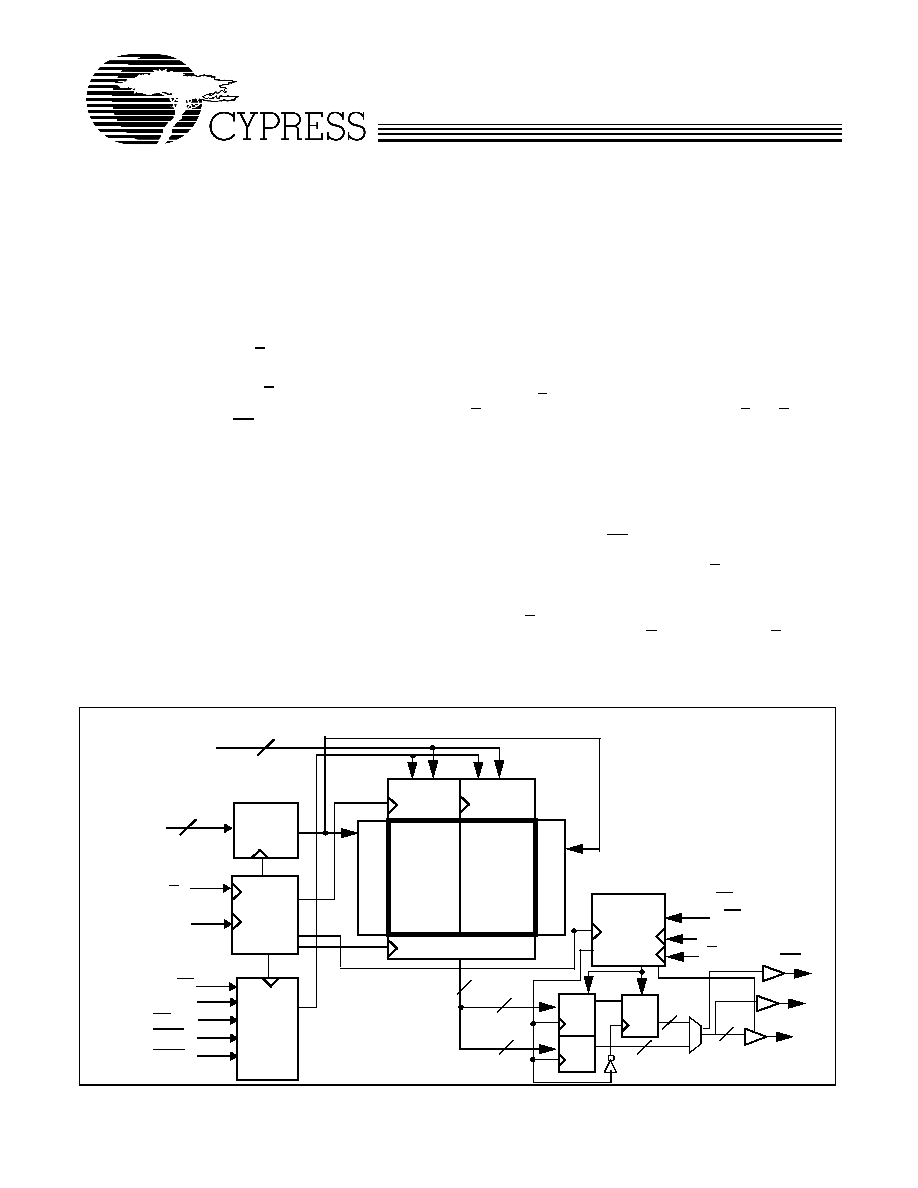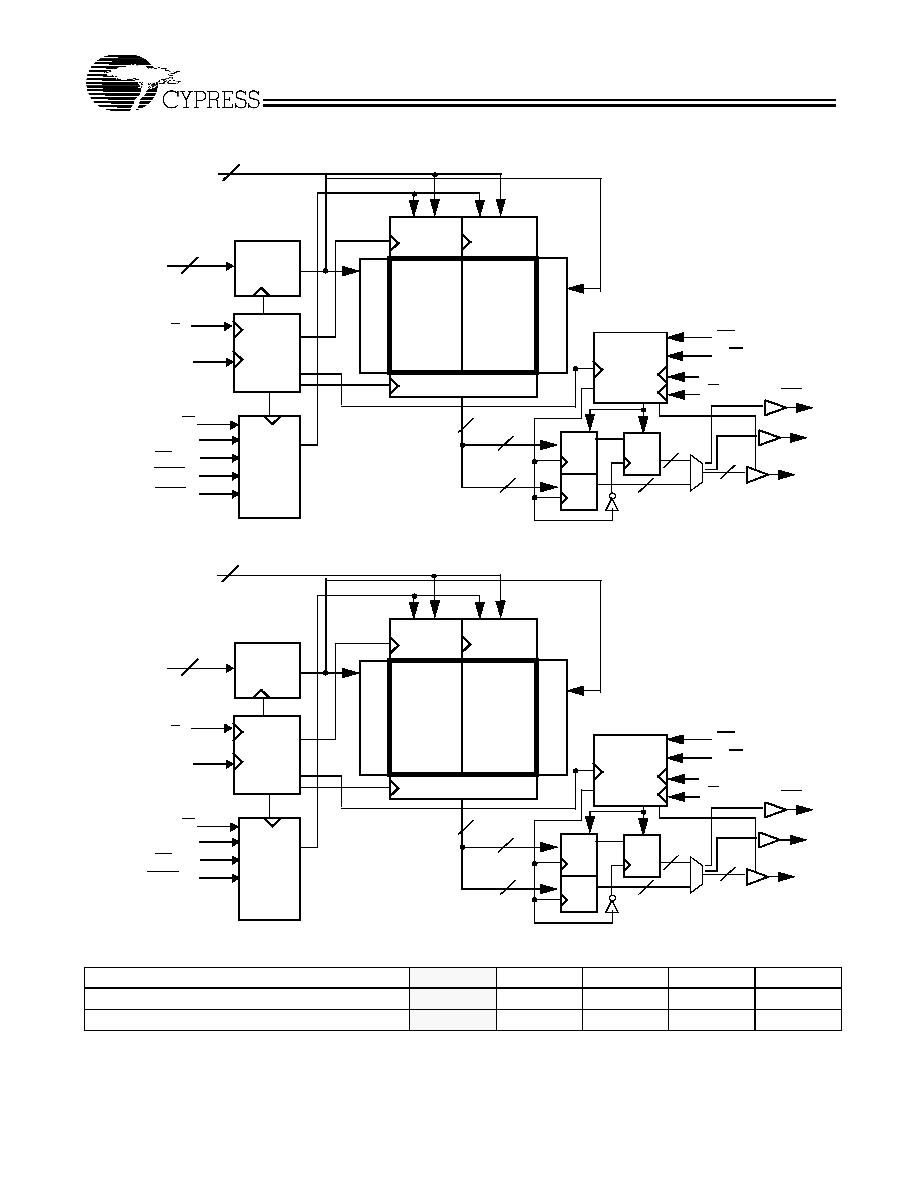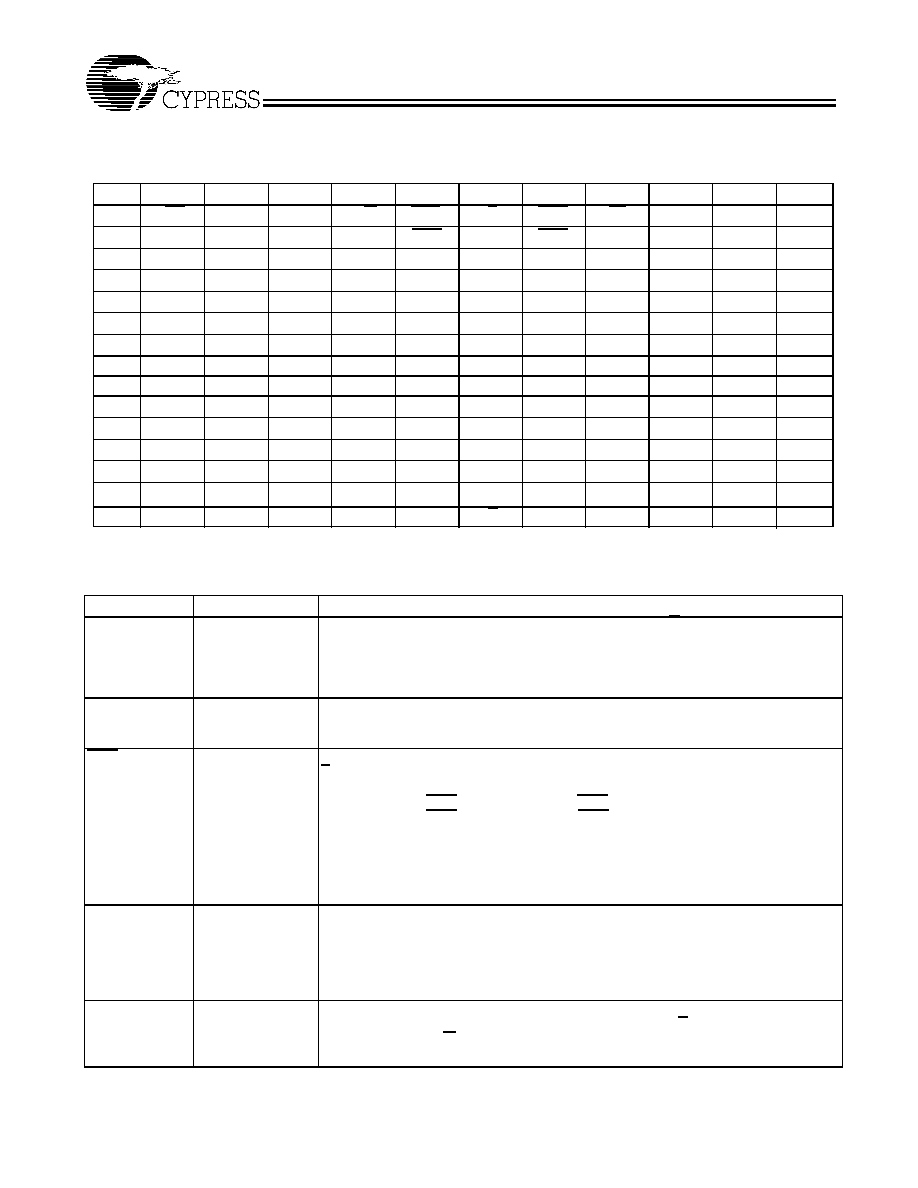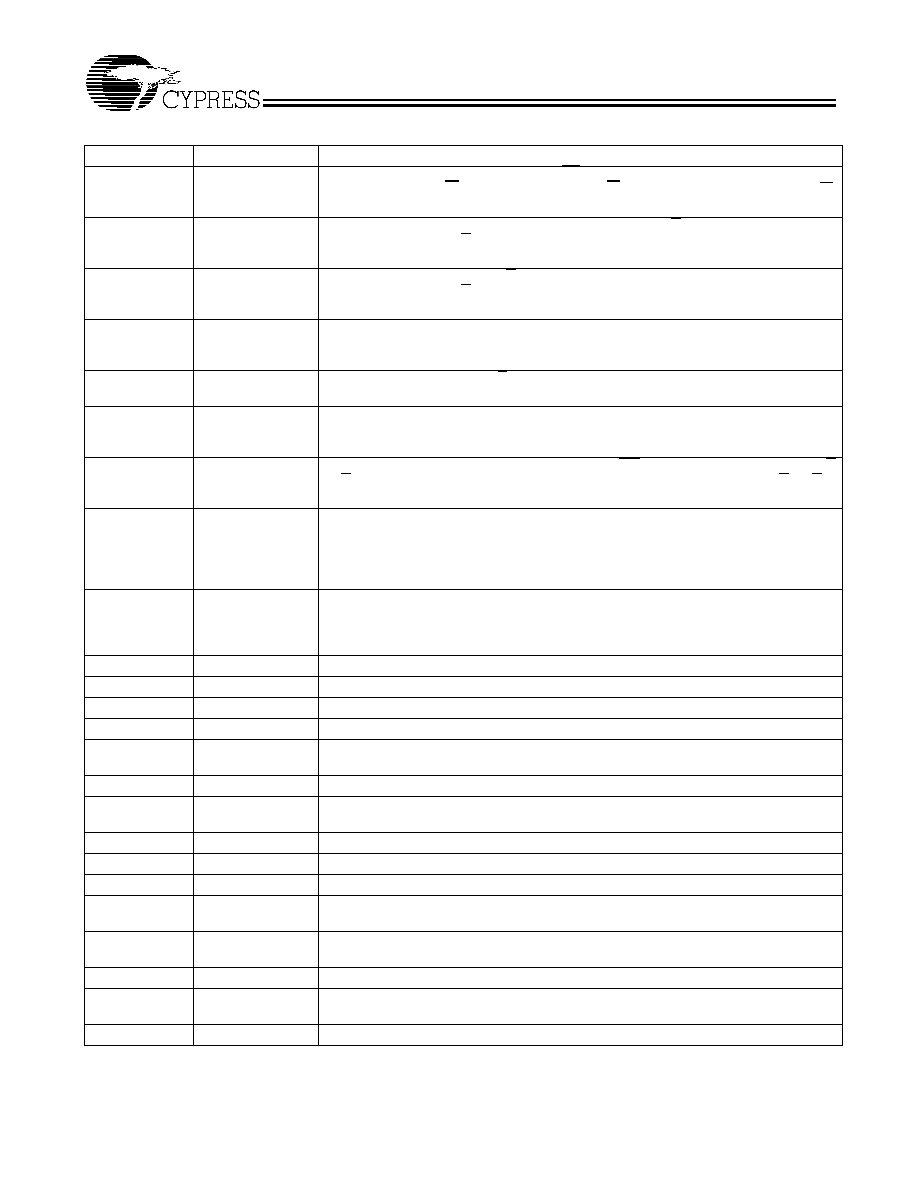/home/web/doc/html/cypress/169527

PRELIMINARY
18-Mb DDR-II SIO SRAM Two-word
Burst Architecture
CY7C1392V18
CY7C1393V18
CY7C1394V18
Cypress Semiconductor Corporation
·
3901 North First Street
·
San Jose
·
CA 95134
·
408-943-2600
Document #: 38-05179 Rev. *A
Revised July 31, 2002
Features
· 18-Mb density (2M x 8, 1M x 18, 512K x 36)
-- Supports concurrent transactions
· 250-MHz clock for high bandwidth
· Two-word burst for reducing address bus frequency
· Double Data Rate (DDR) interfaces (data transferred at
500 MHz) @ 250 MHz
· Two input clocks (K and K) for precise DDR timing
-- SRAM uses rising edges only
· Two output clocks (C and C) accounts for clock skew
and flight time mismatches
· Echo clocks (CQ and CQ) simplify data capture in high
speed systems
· Separate Port Selects for depth expansion
· Synchronous internally self-timed writes
· 1.8V core power supply with HSTL inputs and outputs
· Variable drive HSTL output buffers
· Expanded HSTL output voltage (1.4V1.9V)
· 13x15 mm 1.0-mm pitch fBGA package, 165 ball (11 x 15
matrix)
· JTAG Interface
· On-chip Delay Lock Loop (DLL)
Configuration
CY7C1392V182M x 8
CY7C1393V181M x18
CY7C1394V18512K x 36
Functional Description
The CY7C1392V18/CY7C1393V18/CY7C1394V18 are 1.8V
Synchronous Pipelined SRAMs equipped with DDR-II SIO
(Double Data Rate Separate I/O) architecture. The DDR-II SIO
consists of two separate DDR ports, Read and Write port, to
access the memory array. The Read port has dedicated
outputs and the Write port has dedicated inputs to support
read and write operations concurrently. Access to each port is
accomplished using a common address bus. Addresses for
Read and Write are latched on alternate rising edges of the
input (K) clock. Write data is registered on the rising edges of
both K and K. Read data is driven on the rising edges of C and
C if provided, or on the rising edge of K and K if C/C are not
provided. Each address location is associated with two 8-bit
words in the case of CY7C1392V18, two 18-bit words in the
case of CY7C1393V18, and two 36-bit words in the case of
CY7C1394V18, that burst sequentially into or out of the
device.
Asynchronous inputs include impedance match (ZQ).
Synchronous data outputs are tightly matched to the two
output echo clocks CQ/CQ, eliminating the need for separately
capturing data from each individual DDR-II SIO SRAM in the
system design. Output data clocks (C/C) enable maximum
system clocking and data synchronization flexibility.
All synchronous inputs pass through input registers controlled
by the K/K input clocks. All data outputs pass through output
registers controlled by the C/C input clocks (or K/K in single
clock mode). Writes are conducted with on-chip synchronous
self-timed write circuitry.
Logic Block Diagram (CY7C1392V18)
1M x 8
CLK
A
(19:0)
Gen.
K
K
Control
Logic
Address
Register
D
[7:0]
Read A
dd.
Decod
e
Read Data Reg.
LD
Q
[7:0]
Control
Logic
Reg.
Reg.
Reg.
8
8
16
Write
8
BWS
0
V
REF
W
r
it
e Add.
Decode
Data Reg
Write
Data Reg
Memory
Array
1M x 8
Memory
Array
8
8
20
8
C
C
BWS
1
R/W
LD
R/W
CQ
CQ

PRELIMINARY
CY7C1392V18
CY7C1393V18
CY7C1394V18
Document #: 38-05179 Rev. *A
Page 2 of 24
Selection Guide
300 MHz
[1]
250 MHz
200 MHz
167 MHz
Unit
Maximum Operating Frequency
300
250
200
167
MHz
Maximum Operating Current
TBD
TBD
TBD
TBD
mA
Note:
1.
Shaded cells indicate advanced information.
Logic Block Diagram (CY7C1393V18)
512K x 18
CLK
A
(18:0)
Gen.
K
K
Control
Logic
Address
Register
D
[17:0]
Read Add.
Dec
ode
Read Data Reg.
LD
Q
[17:0]
Control
Logic
Reg.
Reg.
Reg.
18
18
36
Write
18
BWS
0
V
REF
W
r
it
e A
dd.
Decode
Data Reg
Write
Data Reg
Memory
Array
512K x 18
Memory
Array
18
18
19
18
C
C
BWS
1
R/W
LD
R/W
CQ
CQ
Logic Block Diagram (CY7C1394V18)
256K x 36
CLK
A
(17:0)
Gen.
K
K
Control
Logic
Address
Register
D
[35:0]
Read Add
.
Decode
Read Data Reg.
LD
Q
[35:0]
Control
Logic
Reg.
Reg.
Reg.
36
36
72
Write
36
BWS
[3:0]
V
REF
W
r
i
t
e Add.
Dec
ode
Data Reg
Write
Data Reg
Memory
Array
256K x 36
Memory
Array
36
36
18
36
C
C
R/W
LD
R/W
CQ
CQ

PRELIMINARY
CY7C1392V18
CY7C1393V18
CY7C1394V18
Document #: 38-05179 Rev. *A
Page 3 of 24
Pin Configurations
CY7C1392V18 (2M x 8) - 11 x 15 FBGA
2
3
4
5
6
7
1
A
B
C
D
E
F
G
H
J
K
L
M
N
P
R
A
CQ
NC
NC
NC
NC
DOFF
NC
V
SS
/72M
A
BWS
1
K
R/W
NC
NC
NC
NC
NC
NC
TDO
NC
NC
D5
NC
NC
NC
TCK
NC
NC
A NC
K
BWS
0
V
SS
A
A
A
NC
V
SS
V
SS
V
SS
V
SS
V
DD
A
V
SS
V
SS
V
SS
V
DD
Q4
NC
V
DDQ
NC
NC
NC
NC
Q7
A
V
DDQ
V
SS
V
DDQ
V
DD
V
DD
Q5
V
DDQ
V
DD
V
DDQ
V
DD
V
DDQ
V
DD
V
SS
V
DD
V
DDQ
V
DDQ
V
SS
V
SS
V
SS
V
SS
A
A
C
V
SS
A
A
A
D4
V
SS
NC
V
SS
NC
NC
V
REF
V
SS
V
DD
V
SS
V
SS
A
V
SS
C
NC
Q6
NC
D7
D6
V
DD
A
8
9
10
11
NC
A
V
DD
/36M
LD
CQ
A NC
NC
Q3
V
SS
NC
NC
D3
NC
V
SS
NC
Q2
NC
NC
NC
V
REF
NC
NC
V
DDQ
NC
V
DDQ
NC
NC
V
DDQ
V
DDQ
V
DDQ
D1
V
DDQ
NC
Q1
NC
V
DDQ
V
DDQ
NC
V
SS
NC
D0
NC
TDI
TMS
V
SS
A
NC
A
NC
D2
NC
ZQ
NC
Q0
NC
NC
NC
NC
A
CY7C1393V18 (1M x 18) - 11 x 15 FBGA
2
3
4
5
6
7
1
A
B
C
D
E
F
G
H
J
K
L
M
N
P
R
A
CQ
NC
NC
NC
NC
DOFF
NC
V
SS
/144M NC/36M
BWS
1
K
R/W
NC
Q9
D9
NC
NC
NC
TDO
NC
NC
D13
NC
NC
NC
TCK
NC
D10
A NC
K
BWS
0
V
SS
A
A
A
Q10
V
SS
V
SS
V
SS
V
SS
V
DD
A
V
SS
V
SS
V
SS
V
DD
Q11
D12
V
DDQ
D14
Q14
D16
Q16
Q17
A
V
DDQ
V
SS
V
DDQ
V
DD
V
DD
Q13
V
DDQ
V
DD
V
DDQ
V
DD
V
DDQ
V
DD
V
SS
V
DD
V
DDQ
V
DDQ
V
SS
V
SS
V
SS
V
SS
A
A
C
V
SS
A
A
A
D11
V
SS
NC
V
SS
Q12
NC
V
REF
V
SS
V
DD
V
SS
V
SS
A
V
SS
C
NC
Q15
NC
D17
D15
V
DD
A
8
9
10
11
Q0
A
GND/72M
LD
CQ
A NC
NC
Q8
V
SS
NC
Q7
D8
NC
V
SS
NC
Q6
D5
NC
NC
V
REF
NC
Q3
V
DDQ
NC
V
DDQ
NC
Q5
V
DDQ
V
DDQ
V
DDQ
D4
V
DDQ
NC
Q4
NC
V
DDQ
V
DDQ
NC
V
SS
NC
D2
NC
TDI
TMS
V
SS
A
NC
A
D7
D6
NC
ZQ
D3
Q2
D1
Q1
D0
NC
A

PRELIMINARY
CY7C1392V18
CY7C1393V18
CY7C1394V18
Document #: 38-05179 Rev. *A
Page 4 of 24
Pin Configurations
(continued)
CY7C1394V18 (512K x 36) - 11 x 15 FBGA
2
3
4
5
6
7
1
A
B
C
D
E
F
G
H
J
K
L
M
N
P
R
A
CQ
Q27
D27
D28
D34
DOFF
Q33
V
SS
/288M NC/72M
BWS
2
K
R/W
BWS
1
Q18
D18
Q30
D31
D33
TDO
Q28
D29
D22
D32
Q34
Q31
TCK
D35
D19
A BWS
3
K
BWS
0
V
SS
A
A
A
Q19
V
SS
V
SS
V
SS
V
SS
V
DD
A
V
SS
V
SS
V
SS
V
DD
Q20
D21
V
DDQ
D23
Q23
D25
Q25
Q26
A
V
DDQ
V
SS
V
DDQ
V
DD
V
DD
Q22
V
DDQ
V
DD
V
DDQ
V
DD
V
DDQ
V
DD
V
SS
V
DD
V
DDQ
V
DDQ
V
SS
V
SS
V
SS
V
SS
A
A
C
V
SS
A
A
A
D20
V
SS
Q29
V
SS
Q21
D30
V
REF
V
SS
V
DD
V
SS
V
SS
A
V
SS
C
Q32
Q24
Q35
D26
D24
V
DD
A
8
9
10
11
Q0
NC/36M V
SS
/144M
LD
CQ
A D17
Q17
Q8
V
SS
D16
Q7
D8
Q16
V
SS
D15
Q6
D5
D9
Q14
V
REF
Q11
Q3
V
DDQ
Q15
V
DDQ
D14
Q5
V
DDQ
V
DDQ
V
DDQ
D4
V
DDQ
D12
Q4
Q12
V
DDQ
V
DDQ
D11
V
SS
D10
D2
Q10
TDI
TMS
V
SS
A
Q9
A
D7
D6
D13
ZQ
D3
Q2
D1
Q1
D0
Q13
A
Pin Definitions
Pin Name
I/O
Pin Description
D
[x:0]
Input-
Synchronous
Data input signals, sampled on the rising edge of K and K clocks during valid write
operations.
CY7C1392V18
-
DQ
[7:0]
CY7C1393V18
-
DQ
[17:0]
CY7C1394V18
-
DQ
[35:0]
LD
Input-
Synchronous
Synchronous Load: This input is brought LOW when a bus cycle sequence is to be
defined. This definition includes address and read/write direction. All transactions
operate on a burst of 2 data (one period of bus activity).
BWS
[3:0]
Input-
Synchronous
Byte Write Select 0, 1, 2, and 3
-
active LOW. Sampled on the rising edge of the K and
K clocks during write operations. Used to select which byte is written into the device
during the current portion of the write operations. Bytes not written remain unaltered.
CY7C1392V18
-
BWS
0
controls D
[3:0]
and BWS
1
controls D
[7:4]
.
CY7C1393V18
-
BWS
0
controls D
[8:0]
and BWS
1
controls D
[17:9].
CY7C1394V18
-
BWS
0
controls D
[8:0]
, BWS
1
controls D
[17:9]
, BWS
2
controls D
[26:18]
and
BWS
3
controls D
[35:27]
All the byte writes are sampled on the same edge as the data. Deselecting a Byte Write
Select will cause the corresponding byte of data to be ignored and not written into the
device.
A
Input-
Synchronous
Address Inputs. Sampled on the rising edge of the K clock during active read and write
operations. These address inputs are multiplexed for both Read and Write operations.
Internally, the device is organized as 2M x 8 (2 arrays each of 1M x 8) for CY7C1392V18,
1M x 18 (2 arrays each of 512K x 18) for CY7C1393V18 and 512K x 36 (2 arrays each
of 256K x 36) for CY7C1394V18.
All the address inputs are ignored when the appropriate port is deselected.
Q
[x:0]
Outputs-
Synchronous
Data Output signals. These pins drive out the requested data during a Read operation.
Valid data is driven out on the rising edge of both the C and C clocks during Read
operations or K and K when in single clock mode. When the Read port is deselected,
Q
[x:0]
are automatically three-stated.

PRELIMINARY
CY7C1392V18
CY7C1393V18
CY7C1394V18
Document #: 38-05179 Rev. *A
Page 5 of 24
R/W
Input-
Synchronous
Synchronous Read/Write Input: When LD is LOW, this input designates the access
type (Read when R/W is HIGH, Write when R/W is LOW) for loaded address. R/W
must meet the set-up and hold times around edge of K.
C
Input-
Clock
Positive Output Clock Input. C is used in conjunction with C to clock out the Read data
from the device. C and C can be used together to deskew the flight times of various
devices on the board back to the controller. See application example for further details.
C
Input-
Clock
Negative Output Clock Input. C is used in conjunction with C to clock out the Read data
from the device. C and C can be used together to deskew the flight times of various
devices on the board back to the controller. See application example for further details.
K
Input-
Clock
Positive Input Clock Input. The rising edge of K is used to capture synchronous inputs
to the device and to drive out data through Q
[x:0]
when in single clock mode. All accesses
are initiated on the rising edge of K.
K
Input-
Clock
Negative Input Clock Input. K is used to capture synchronous inputs being presented
to the device and to drive out data through Q
[x:0]
when in single clock mode.
CQ
Input-
Clock
Positive Output Echo Clock. The rising edge of CQ is synchronous with respect to C
(or K in single clock mode) and is used for data valid indication coming off of C (or K)
clock. This is a free-running clock.
CQ
Input-Clock
Negative Output Echo Clock. The rising edge of CQ is synchronous with respect to C
(or K in single clock mode) and is used for data valid indication coming off of C (or K)
clock. This is a free-running clock.
ZQ
Input
Output Impedance Matching Input. This input is used to tune the device outputs to the
system data bus impedance. Q
[x:0]
output impedance are set to 0.2 x RQ, where RQ is
a resistor connected between ZQ and ground. Alternately, this pin can be connected
directly to V
DD
, which enables the minimum impedance mode. This pin cannot be
connected directly to GND or left unconnected.
DOFF
Input
DLL Turn Off. Connecting this pin to ground will turn off the DLL inside the device. The
timings in the DLL turned off operation will be different from those listed in this data sheet.
More details on this operation can be found in the application note, "DLL Operation in
the QDR
TM
-II."
TDO
Output
TDO for JTAG.
TCK
Input
TCK pin for JTAG.
TDI
Input
TDI pin for JTAG.
TMS
Input
TMS pin for JTAG.
NC/36M
Input
Address expansion for 36M. This is a No connect on the 18M and could be tied to any
level on the 18M devices
GND/36M
Input
Address expansion for 36M. This should be tied LOW on the 18M devices.
NC/72M
Input
Address expansion for 72M. This is a No connect on the 18M and could be tied to any
level on the 18M devices
V
SS
/72M
Input
Address expansion for 72M. This must be tied LOW on the 18M SRAM.
V
SS
/144M
Input
Address expansion for 144M. This must be tied LOW on the 18M SRAM.
V
SS
/288M
Input
Address expansion for 288M. This must be tied LOW on the 18M SRAM.
V
REF
Input-
Reference
Reference Voltage Input. Static input used to set the reference level for HSTL inputs
and Outputs as well as A/C measurement points.
V
DD
Power Supply
Power supply inputs to the core of the device. Should be connected to 1.8V power
supply.
V
SS
Ground
Ground for the device. Should be connected to ground of the system.
V
DDQ
Power Supply
Power supply inputs for the outputs of the device. Should be connected to 1.5V
power supply.
NC
NC
No connect.
Pin Definitions
(continued)
Pin Name
I/O
Pin Description




